
A Weekend Roundup (And One Simple Formula)
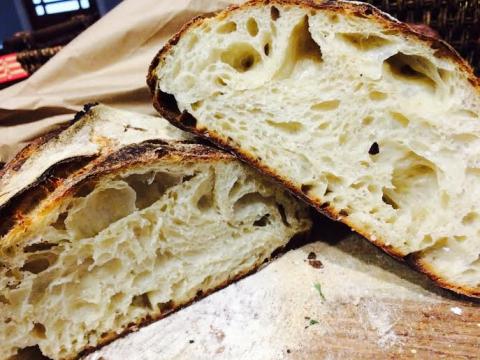
Phew. I've baked for a number of friends over the last few days! Many of them just wanted or needed a very generalized designation of "bread" for events, so I was able to experiment a bit with sourdough baking.
Disclaimer: All ciabatte described are "pre-dabrownman-flip-recommendation," so don't judge me too harshly...I still haven't acquired a second pastry scraper, so all ciabatta experiments are on a temporary hold...
Saturday, I baked some whole wheat ciabatte and a few small simple batards.



also, a small parmesan-encrusted boule, and a small sesame-encrusted batard.

Then on Sunday, a few more ciabatte -- this time with cream cheese and chive.
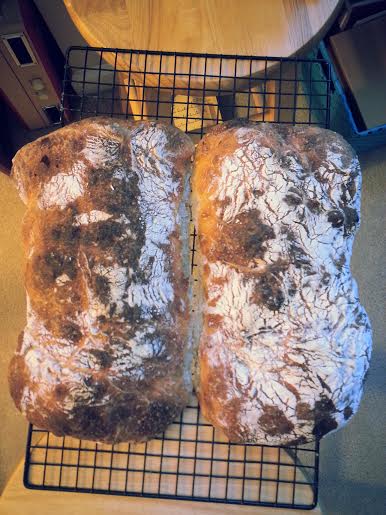
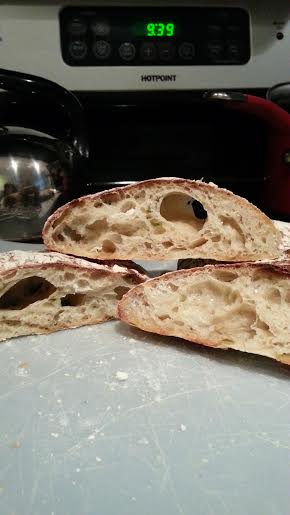
And then just this morning, Monday, before work: A simple 80% hydration batard with 5% levain. Still working on my shaping. Still striving for those ears.
Because my friend just emailed me saying that this was her favorite bread I've given her, I'll post a very basic formula:
Ingredients:
425 g AP flour
50 g whole wheat flour
375 g water
5 g wheat germ
11 g salt
10 g sugar (in place of 5 g malt)
50 g 100% hydration white starter
Steps:
1) Mix flour and water, and autolyse at room temperature for 6-12 hours.
2) Incorporate all other ingredients using the pincer method. This should take about 4 minutes. You'll notice that because the dough was already so wet, incorporating that small amount of 100% hydration levain, salt, sugar, and wheat germ is a surprisingly smooth process.
3) Stretch and fold vigorously every 30 minutes for 3 hours. The number of turns depends on how the dough feels! Anywhere from 1-4 turns (4-16 folds), each session, performing the turns until the whole mass of dough wants to lift from the container.
4) Rest on the counter for 8-12 hours, until dough has increased 80% - 100%, but no more.
5) Retard for 2-24 hours.
6) Sprinkle flour over the top of the dough in the container, and allow the flour to coat the edges as you gently release it. Pour onto a floured surface and rest for 10 minutes.
7) Shape and place seam-side up in a a brotform of some kind, cover with plastic, and proof at room temperature for 1.5 hours.
8) Place the brotform in the freezer for 15 minutes (I really like this freezer trick for high-hydration doughs proofed at room temperature...I genuinely think it helps with ovenspring!).
9) Score and bake at 460 for 20 minutes with steam, 25 minutes without.
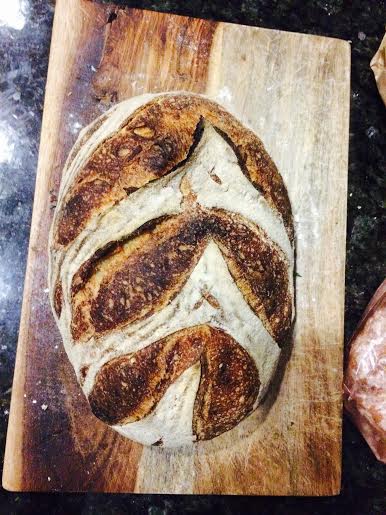

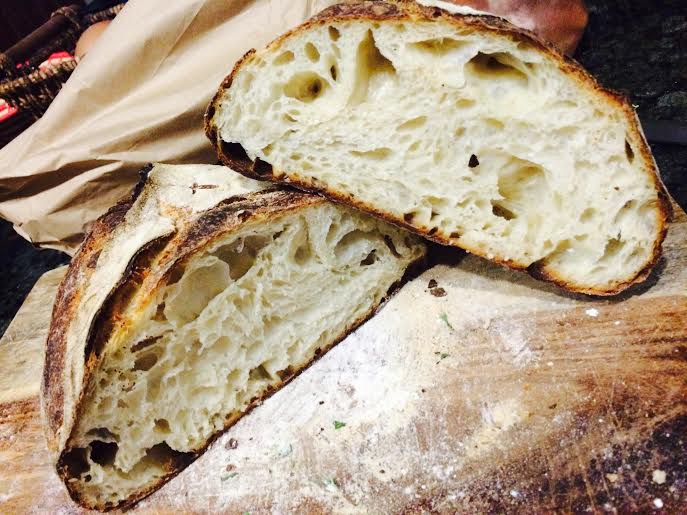

The recipient has confirmed the appropriateness of the loaf for egg-dipping.
More soon!
--Hannah


Comments
Just dust the loaves with flour and quickly and carefully roll them over onto the already floury couche. then quickly pick them up, stretch lightly and place on baking apparatus. Just dust your hands with flour as needed and be quick with your motions.
By the way the bread looks great
Josh
I will try to build up the confidence! I tried to push up to 90% hydration for a few of those loaves, and they just seem to absorb dusting flour before I can move them. But I will take a deep breath and give it a go later this week!
Looks great! Would you mind if I shared this on the homepage for a bit?
...I'd be honored!
What a busy weekend!
Beautiful baking. Your friends should be very happy and full!
Curious about your ciabatta with cream cheese and chives recipe. Please share if you don't mind.
so i use my favorite large pancake spatula for the other.hand:-) Now Josh is going to get you to give it a gentle tug too before going onto parchment on a peel, I know it sounds weird, like flipping them over, but it will make a difference. The first time I ever heard of such a tug crazy thing was here Pierre Nury’s Rustic Light Rye - Leader where zolablue's method for this bread had a gentle tug on it too before being flopped back down on the parchment. I have no idea what this tug does but both Josh and Zola are great bakers. I highly suggest that you read zolablue's blog too.
All of your bread looks fantastic and the feature on the home page is proof.!
Well done and happy baking
As I've said elsewhere, that is one crumb to die for. No surprise Floyd wanted to highlight it. Looks like you could eat it with a spoon.
OK, that's it. I'm going to try this freezer trick. The most novel gimmick I've read here in years.
Fun post. Thanks a_w_t.
Tom
Thanks for all of the kind words...and dabrowman, for the tug trick!
Per isand66, here is the formula for the cream cheese and chive ciabatta:
Ingredients:
350 g Ap flour
75 g whole wheat flour
375 g cold water
60 g cream cheese
15 g finely chopped fresh chives
11 g salt
10 g sugar or 5 g malt
150 g 100% hydration starter (I used my 50% rye, 50% AP fl starter here, but any 150 g of ripe levain will do!)
Method :
1) Mix flour and water, and autolyse for 6-12 hours.
2) Mix in other ingredients until fully incorporated; this will take about 3-4 minutes.
3) Slap and fold for 2 minutes.
4) Stretch and fold 1-4 full turns every 30 minutes for 2.5 hours.
5) Rest on the counter until roughly doubled (or just a bit less), 2-6 hours.
6) Retard for 2-24 hours.
7) Sprinkle flour over the top of the dough in the container, and pour onto floured surface. Divide into two pieces, and fold each piece in half.
8) Proof for 1 hours 20 minutes. (At this point, the best thing would be to flip the dough and let it rest for 10 minutes, as dabrowman suggests! I haven't done it yet, but I'm sure it improves the crumb.)
9) Bake at 460 for 10 minutes with steam, 20 minutes without. Turn after the 20th minute, if you can manage it.
That one is a crowd-pleaser! The cream cheese compliments the sourdough nicely.
Thanks. I've incorporated cream cheese into rolls but never Ciabatta so I will have to give this one a try.
You may interested in one I made a while ago. No starter in this one, but it was one of my favorites. https://mookielovesbread.wordpress.com/2012/02/25/ciabatta-with-carmelized-onions-rye-spelt-flours/
...that custard-crumb looks out of this world. So much fun to follow your experiments! You are a great inspiration!
Nice work Hannah! Your crumb and crust look superb. No wonder your friends are so happy.
You mentioned parmesan encrusted boule. That sounds delicious. When did you add the parmesan and how much?
And I love the use of wheat germ. I've used it in my banneton instead of flour and it makes for a nice crispy coating.
Cheers!
Dave
Great bread,
Why do you retard after 12 hours of bulk fermentation? What is the scope?
isand66, thank you for the wonderful recipe! I look forward to trying it.
And thanks for the other kind comments. To address a few questions:
Dave, I actually just grated a good amount of parmesan, sprayed the loaf with water before scoring, sprinkled on as much as it would take, and sprayed a bit more water on top to "seal" it. This is the same process I use to seal seeds on the crust of bread, and it seems to work! I've made a number of parmesan and asiago-encrusted loaves, and they are always well-received. It's a great way to add some character to an otherwise straightforward loaf.
coltuc, I try to retard during either bulk fermentation or final proof for almost all of my loaves. Luckily, I usually NEED to do it to fit the amount of baking I do around my work schedule, but I also do it to create the more complicated flavors that result from production of more lactic and acetic acid. I think that people have a range of opinions about the effect of retarding on sourdough flavor, and to be honest, I've baked long-bulk-retarded loaves that have ended up quite tart...but most of the time, I feel that retarding during bulk creates a mellower, maltier flavor than I achieve with a long room-temperature bulk with no retarding. I am by no means experienced enough to accurately lay out the effects of retarding at different stages, but I love experimenting with it. And two things I know for sure:
1) High-hydration dough that's been retarded during bulk is way easier to shape, which is fantastic, and...
2) Retarding during bulk is more forgiving than retarding during the final proof. It takes up more space in the fridge, but it's worth it. I don't need all those jars of sauces anyway!
Thank you for your answer. I always retard during secod fermentation. I too use very hydrated dough using Chad's techinque for shaping. It wasn't clear for me why tou retards after a long bulk fermentation. Did you tried also to retard the second fermentation too after the long bulk fermentation?
I mainly retard during bulk because the dough is less likely to over-proof with that long cold bulk. I have had beautiful results retarding only during final proof, but I am not a skilled enough baker yet to always properly gauge how much time a shaped loaf needs at room temp, then in the fridge, then at room temp again, before bake. And with high-hydration doughs it's even harder, because the poke test doesn't work!
I've retarded during both bulk and proof with mixed results. I did great baguettes that way once, but I've also baked more than a few tired-looking loaves. I do think that there is such a thing as too much cold for the poor yeast to manage!
the fridge is your best friend when it comes to making a forgiving bake schedule around work, family or for anything else more important than bread. And it is also true, although I've never heard it before, that bakers don't need no stinking sauces in the fridge that keep the bread out of it! Well said:-)
Very nice looking loaves! The crusts look amazing!
How do you steam your oven and on what surface do you bake them?!
Thanks!
For boules, I often still use a dutch oven or a Lodge Combo Cooker. For batards (including the featured one), I like to use a baking stone with a large turkey roaster lid. I'm experimenting with other steaming methods, though, because the roaster limits the number and size of loaves to be baked at once far more than I'd like. Sometimes I want the freedom to bake a large boule and a large batard at once, on the stone!
impressive!
The loaf disappeared so quickly, I didn't get around to taking pix. Best of all is learning that freezer trick! I've used it now on several different high(ish---not quite 80%) hydration loaves and it works beautifully. I find it easier to score the chilled dough too.
Cheers!
Cherie
Cherie, I am SO glad you're finding the freezer trick useful!
thanks for sharing your formula and method! I tried it out this weekend except I used about 50/50 KA bread flour and some locally milled fresh whole wheat flour. I loved the results! Definitely more sour than my usual loaves (perhaps from a slightly longer ferment time than I'm used to) I liked the freezer tip and am going to try it out again!
Hi,
I'm enjoying your technique and the loaves look fine but overall they are a bit 'denser' than they should be imo.
My kitchen is rather cold this time of year overnight 65* and the dough is not rising to your 80% plus range.
I can try and put it in the oven with the light on but I was just curious about your room temp.
Great looking bread!!
Thanks,
dtrap
I tried to follow your recipe - nice flavour, but I ended up with a terrible flat loaf. How tight do you shape it? And how much do you degas the dough? And do you preshape or not (was sure wether to preshape or not before the 10 minutes rest on the counter)? Your loaves always look great (and hopefully you will soon post more) :-)
these loaves look absurdly delicious and sexy!
Hi, Where did the original inspiration recipe come from for this loaf? thanks a lot.
wanted to know where you first came up with this recipe. thanks. anina
Thank you for this recipe. I know I want to try this, but it is going to take some serious planning! Use a spread sheet?
doing the freezer trick. The first time I tried that. When I dumped the dough out of the banneton onto the baking stone it seemed really flat and I thought 'oh-oh' this is not going to work, but about 10 minutes later it really 'inflated' and the result was very satisfactory which gave me new confidence in baking these high hydration sourdough loaves. Thank you very much!
I used strong bread flour of 12% protein.
I'm new to bread baking so I hope you don't mind my questions. I'm curious, why autolyse for 6-12 hours? I have only seen people do it for 30 mins. Thanks!
Also another question, I am babystepping on the Tartine basic country bread trying to get the feel for things before I try other recipes. I see you do final proof of 6-12 hours, so can I do the final overnight proof on counter instead of fridge to increase the country bread size (my kitchen is about 65 degrees or colder at night)? My dough doesn't puff up in the fridge and the seam side on top of loaf gets hard and dry even covered with tea towel.
Thanks!
Hello, I tried the 15 minutes in the freezer while the dough\ is in the basket and covered with a plastic bag yet did not feel the dough cold at all and the scoring was shabby any advice? thanks